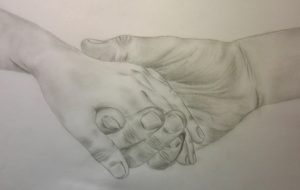Diversity
image by Sheng P.
My novel The Kitchen Daughter was published in 2011. Seven years is not that long ago, really, but for many reasons, it feels like a different lifetime. The world has changed a great deal in less than a decade, and publishing has changed along with it—in ways both negative and positive.
When I made the decision to write a novel from the perspective of a character on the autism spectrum, such books were relatively rare on bookstore shelves. Basically, if people had read a book with an autistic narrator, it was almost certainly Mark Haddon’s The Curious Incident of the Dog in the Night-Time. (Which of course, in certain circles, gave rise to the typical publishing conversation of “Isn’t your book kind of like a book that already exists?” And the standard, exasperated answer, “Yes, except not at all.”)
In the beginning, my decision to write from an autistic character’s perspective originated from a logical place, not an emotional one. I love to cook, and when I prepare meals, I’m doing it to connect with people. I wanted to write about someone who cooks without any intention of connecting—someone isolated partly by circumstances and partly by choice—but who comes to realize that she can use cooking to connect.
When I began writing the book, I had recently met the writer John Elder Robison, whose memoir Look Me in the Eye brought what was then called Asperger’s Syndrome to the attention of many. After delving into everything I could find written on the topic, including first-person accounts written by women on the spectrum, I made the decision that the narrator I wanted to write had undiagnosed Asperger’s, and the story unfolded from there. I dug in, learned everything I could, worked to define Ginny’s unique experience, enlisted a host of readers who could tell me what didn’t ring true, and wrote and rewrote until the book was the best I could make it.
If I were facing this decision in 2018 instead of 2008, would I have made the same choice? I’m not at all sure.
Read MoreBe impressed with your Writer Unboxed Breakout Novel Dissection Group. In our last round of discussions, we dissected not one, but three novels. All at once. We were trying something new, just this once, and there’s a good reason why.
If you have been following posts from the dissection group, you know that four times a year we ask members to nominate a recent novel they’d want to discuss in order to understand the mechanics that led to its breakout success. From half a dozen nominees, members vote to select the one novel we’ll dissect.
Members of the dissection group are writers (and readers) of all genres. Thus, we’ve ended up dissecting novels from nearly every genre: sci fi, dystopian, literary, women’s, historical, young adult, humor, thriller…
The range has been satisfying. Don Maass’s writings on breakout fiction – on which our group bases its dissections – recognize that the craft underlying breakouts applies across genre. In Writing 21st Century Fiction, he underscores that high-impact fiction merges both character- and plot-driven craft, propelling breakout success. And a frequent observation after dissections is how much participants gain from discussing novels in genres outside their typical reading or writing tastes.
Still… going into last year, the moderators and members of the group expressed a greater push for diversity. The democracy of picking one book often left stellar second and third choices. And – as much as we’d seen some range in author and main character diversity – we noticed that those near-misses would have included greater diversity in gender, race and culture.
So in July, we tried an experiment. Rather than reading only one top vote, we culled a poll from all of those near-misses, and then dissected the top three, which yielded this amazing list:
Warning: If you haven’t read the novel(s), know that SPOILERS MAY BE PRESENT in shared excerpts here or on the Facebook discussion.
Three books, one discussion.
Before you panic on behalf of our participants: members only had to read one of the books to participate (although our group is full of avid readers, so many had read two or all three of the books). We provided guidelines and summaries to keep things clear.
There are lots of reasons why this was a successful experiment. It allowed us to get to three books that had repeatedly been suggested by participants, where we might only have gotten to one or have missed these titles altogether. Sometimes we’ve lost participation when people were disappointed a great book wasn’t chosen — and we were legitimately stoked to be more inclusive with more choices.
And, from a craft perspective, it allowed us to compare side by side the ways each writer attempted (or ignored) aspects of breakout fiction. As we all know from workshop discussions, those kind of comparisons can lead to fresh insights.
Threads of Breakout Characteristics
Our group uses a set of questions – approximately six per day for a week – derived from Don Maass’s advice in Writing the Breakout Novel. From the dozens of insights participants shared, here are a few highlights that stood […]
Read MorePhoto by João Silas on Unsplash
I’ve been getting some interesting questions while on book tour.
1 – Do you plan on all on your novels being so political?
And
2 – How come your novel doesn’t get more political?
The funny thing is, these questions actually don’t contradict one another other. In fact, they reveal a lot about how we think of art and politics. They are what happen when we think of art and politics as being two wholly separate things. Rather than seeing them as being organically intertwined, we like to think one can be applied to another in increments or measurements, as if making a novel political is as simple as baking: mix in X or Y amount of Issue A to a plot and you get a novel that is either somewhat or very political.
My life experience does not allow me to see—or even experience—things quite so simply. As an immigrant and a Latina whose recent novel deals with family sacrifice, love, generational trauma, secrets, marriage, adolescence, borders, and immigration, I’m often told things like my novel is very timely, or that the topic of immigration is very relevant right now. I’ve lived my whole life as an immigrant; to me and millions like me, immigration is not a “topic” but a lived experience. We cannot separate politics from our lives because our whole lives there have been policies in place that affect us.
Which is why question #1 (do you plan on all your novels being political?) so often creeps up. What a question like this fails to acknowledge is that all stories are political—the only difference among them is the role those politics play. If they are unperceived in a story, it is only because the people in it are lucky enough to have politics working in their favor: unfelt and unintrusive.
In stories like mine, in a time and setting where the current (and historical) politics obstruct and oppress the lives of the Latinx immigrant communities I’m writing about, the political becomes more visible. It is a force that we do not have the privilege, as much as we’d want to, of ignoring. Even if I were to write a fun, “non-political” story that makes for an escapist read, it’d be difficult to do so authentically because my existence as a woman of color and immigrant is politicized in the world we live in. The example I often give is this:
Read MorePlease welcome Patrice Williams Marks to Writer Unboxed today! Patrice recently reached out to Writer Unboxed to tell us about her free 7-day course on becoming a Sensitivity Reader, and an idea was born; this seemed like a post-worthy topic to us. We’re thrilled Patrice agreed to be our guest today, to answer a few worthy questions:
What is a Sensitivity Reader? Can you be one? Should you utilize one? Will a Sensitivity Reader censor?
A little about Patrice, from her bio:
Patrice Williams Marks is a Sensitivity Reader and Course Creator, founder of a non-profit charity that works to diversify the newsroom. She is the founder of several film festivals with diverse entries from filmmakers and writers. She also has a background in public relations, marketing, and journalism with an emphasis on research.
Learn more about Patrice on her website, and by following her on Facebook and Twitter. And learn more about her course online HERE and through the Sensitivity Read Twitter account. Oh, and Patrice is offering a free webinar on June 28th. Learn more about that HERE.
Enjoy!
What Is a Sensitivity Reader and Can I Become One?
In 2016, Scholastic pulled the children’s book, A Birthday Cake For George Washington, after outrage from what some considered “whitewashing” of the history of slavery.
The book showed “happy slaves” making a cake for George Washington. To those of us with ancestors who lived through that period of time–my father’s grandmother was a freed slave–it was not only hurtful but insulting.
We know that Scholastic (and the authors of the book) had no intention of insulting or whitewashing slavery, but nevertheless, they did just that. How? By writing about a culture they knew little about, and filling in the holes with assumptions though their own limited lenses.
As writers, we all “fill in the holes.” I have. But it has always been after extensive research.
What could they have done differently?
Hired an African-American Sensitivity Reader during the first draft phase of the book.
What exactly is a Sensitivity Reader, and how could s/he have helped?
A Sensitivity Reader is someone who specializes in a specific niche (African-American, Muslim, Physically Challenged, LGBTQ, Little People, etc.) and is a part of the specific marginalized community that the author is writing about. The Sensitivity Reader thoroughly reads over the material for bias, stereotypes, offensiveness, lack of understanding, etc. and creates a report for the client outlining their thoughts, why they feel something may be a problem, and offering possible solutions.
Will a Sensitivity Reader censor the work?
The client makes the final decision whether to make the changes suggested, make only a few changes, or keep the project as is. Therefore, a Sensitivity Reader cannot absolve another author or publishing company of any future negative impacts from their project.
Does a project need more than one Sensitivity Reader?
Possibly. If you are writing about more than one marginalized group, and you are not part of those groups, then you would do well to hire Sensitivity Readers who specialize in each group.
Read More
At Qutb Minar. Image – iStockphoto: Train Arrival
Because Diversity Is So…Diverse
If you’ve ever flown to New Delhi, you’ll have encountered one of the more peculiar time-zone anomalies in world travel: The mighty capital of India is not just 10 hours ahead of Eastern time, it’s 10 hours and 30 minutes ahead. Like Tehran, New Delhi has a half-hour time change atop the usual whole-zone adjustments.
And when I was in New Delhi this week for the International Publishers Association’s (IPA) biennial world congress, an interesting situation developed. As I wrote it up at Publishing Perspectives, the stage was busy with many publishing and intellectual property players, most of them rightly energized and newly sensitized by the political realities around us today.
In a nutshell:
As many as 70 national associations’ representatives were at the conference, which was designed as three days of intensive, relentless presentations, debates, and discussions around the key issues impacting the world industry. The event drew close to 400 people–with probably 400 views of what we mean when we say “diversity.”
In my congress-closing article, it fell to me to point out that the concept of gender diversity in publishing’s leadership had gotten away from the planners. We watched as waves of talented, intelligent men moved across the stage, but the organization fell short of its goal of gender parity in these presentations. Even some of the most prominent women publishers in India, well known to many of us in the international business, were oddly missing from programming. The local organizers had focused elsewhere and surely felt they were entertaining a fabulously diverse audience with as many as 60 nations’ delegates in place.
The international association has handled this criticism extremely well, without defensiveness. This is very much to the IPA’s credit, how constructive.
And what’s important to recognize, of course, is that an outfit like the IPA has the interesting dilemma of occasionally competing constituencies. In a congress cycle that’s hosted by a market like India still laboring with a major overhang of traditional male domination, the dynamic of the wider, multinational group can end up in conflict with the interests of the local hosting body.
The next IPA congress is set in Norway, and it’s logical to expect a very different reality there; the Nordic and Scandinavian publishing markets have long reflected their societies’ more even-handed gender relations.
Nevertheless, the experience in New Delhi–on the […]
Read MoreIn the nearly three weeks since white supremacists marched in Charlottesville, Virginia, many of us have been (rightfully so) discussing ways to combat hate and dismantle systemic racism.
But the truth is, these conversations have always been urgent and necessary. And not just in that large-scale, overwhelming, how-do-we-stop-more-white-supremacists-from-marching kind of way. Our efforts to build a more just and equal society cannot be reactionary, galvanized only by tragedy. They must be happening constantly, in large and small scales, in each of our communities.
This includes our community of writers, editors, and publishers. What happened in Charlottesville is a chilling example of why diverse representation matters in the books and media we consume. It’s a chilling example of why sensitivity reads are not about censorship, but preventing harm. A book that stereotypes its characters of color and a Neo-Nazi march may be two very different things, but they exist on the same plane and slope. No one lights a torch and joins a hate-fueled march without ever having been exposed to ideas that—intentionally or not—dehumanize people who are different from them.
That being said, this is not a post about how to write the other (this, however, is a very good one). This is a post about writers of color, and the kind of help and actions we most need most from our white writer allies. To all who have felt helpless, or asked what you can do, here are some ways to be better allies, compiled by me and other writers of color whom I asked to weigh in.
Read MorePlease welcome back author Elizabeth Stephens, who’s here to further the discussion of a somewhat controversial but important topic: Should white writers craft protagonists of color, or vice-versa? A little about Elizabeth from her bio:
Elizabeth Stephens–a self-acknowledged weirdo who has been writing since the age of 11–is a mixed race (black and white) romance and science fiction author and reader of all things that feature tough leading ladies. Her newest release, The Hunting Town, came out July 16, 2017 and is a small town, mafia romance. Last year saw the publication of Saltlands, book two in her dystopian romance series which began with Population. She is a big fan of inclusion and her books always include kick ass ladies of color.
Her day job is in communications for public and private sector clients across Africa.
When she isn’t writing or day-jobbing she can most often be found reading, drawing, throwing pottery, watching horror movies, and protesting for causes that she hopes will make the world a better place for all.
Learn more about Elizabeth and The Hunting Town on her website (where you can find a free self-publishing guide), and by following her on Twitter and Facebook.
White Writers Writing Non-White Characters: Why I Vote Yes, for Commercial Fiction
I recently came across an article in which an author advocated that white writers should not feature characters of color as leading protagonists in their novels. This author made some compelling points that I believe are critical to consider for all writers of literary fiction looking to portray characters outside of their race. Are you a white author trying to tell the story of a disenfranchised Mexican immigrant? Maybe reconsider.
However, are you a white author of erotica looking to cast a dark-skinned black woman as your leading lady? Please, write on! Because when it comes to mainstream, commercial, and genre fiction, I would wholeheartedly challenge this author’s assumption. Characters of color do just as much for minority empowerment as the authors who write them. Thus, I urge this author and others who share the same opinion to place a small asterisk in their argument. Here’s why:
We need to acknowledge some (frustrating) facts.
Read More



















